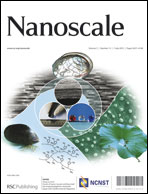One-step fabrication of intense red fluorescent gold nanoclusters and their application in cancer cell imaging†
Abstract
A one-step method for successfully fabrication of water-soluble and alkanethiol-stabilized Au nanoclusters (NCs) was demonstrated. The novel and facile method was based on simply placing histidine (His), HAuCl4 and 11-mercaptoundcanoic acid (MUA) together at room temperature. The resulting Au NCs were exclusively composed of Au17MUA4His22 (AMH), as demonstrated by the photoluminescence, UV-Vis absorption, electrospray ionization mass and X-ray photoelectron spectroscopy. AMH exhibited intense red fluorescence (λem = 600 nm), a long fluorescence lifetime (7.11 μs), considerable stability, and a large Stoke’s shift (320 nm). Based on the excellent properties of the AMH, cell experiments were conducted. Cytotoxicity studies showed that the Au NCs exhibited negligible effects in altering cell proliferation or triggering apoptosis. Cancer cell imaging of HeLa cell lines indicated that the obtained AMH could serve as a promising fluorescent bioprobe for bioimaging. This strategy, based on the one-step method, may offer a novel approach to fabricate other water-soluble and alkanethiol-stabilized metal nanoclusters for application in biolabelling and bioimaging.


 Please wait while we load your content...
Please wait while we load your content...